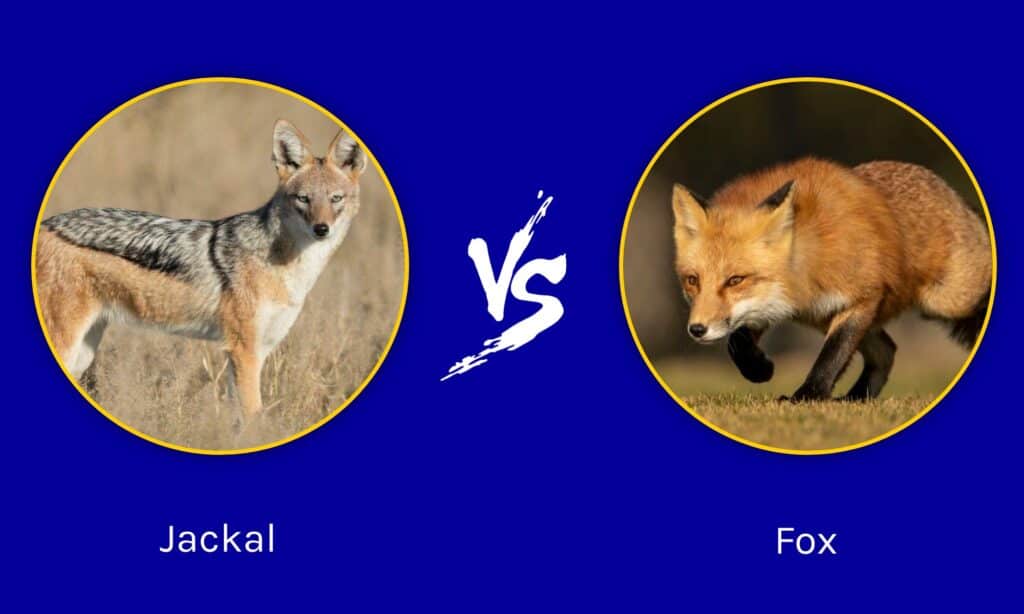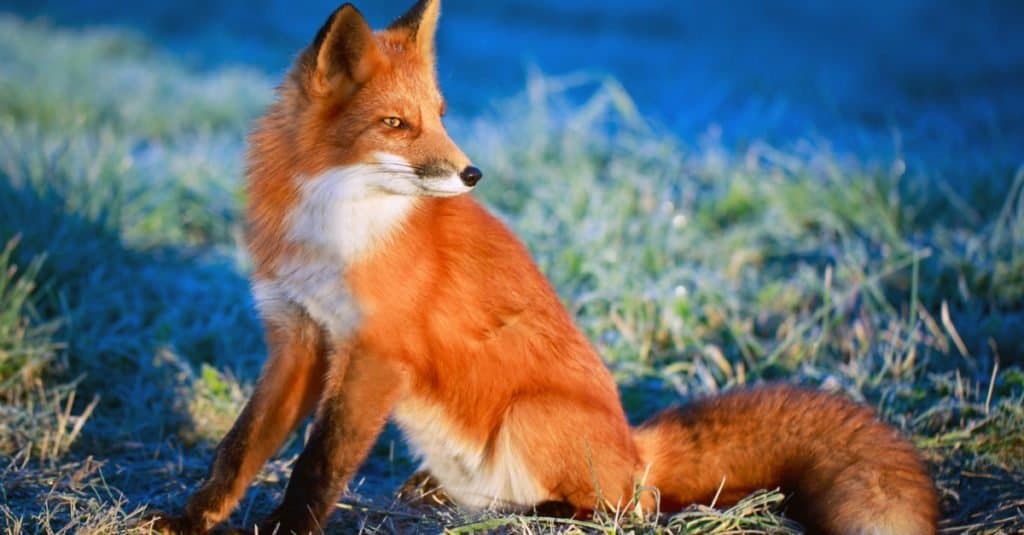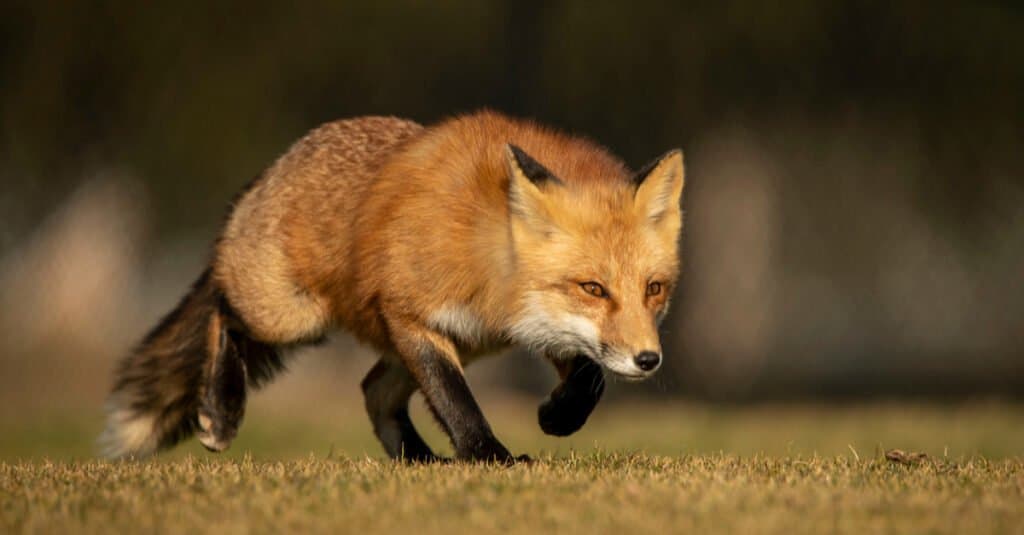Jackals are animals that make their homes in different parts of Africa as well as in European countries. They are omnivores, eating both plants and meat. Male and female jackals are monogamous, meaning they stay together throughout their lives and raise their pups together. These canines can live up to 12 years in the wild.
The scientific name for jackals is Canis aureus; Canis is Latin for dog, and aureus means golden. Hence, it is also fine to call them golden jackals.
The fox is a scavenger carnivore animal generally found in urban areas in the Northern Hemisphere. As nocturnal animals, foxes prefer going out at night to hunt for prey.
The scientific name for the fox is Vulpes vulpes. The genus Vulpes has 12 different species of foxes. But the most common is the red fox – Vulpes vulpes.
It is possible to observe jackals and foxes and be unable to tell them apart as they share very striking similarities. But with detailed insight, you can resolve this problem and be your little expert on their differences. Shall we?
Comparing Jackals vs Foxes

| Jackal (Canis aureus) | Fox (Vulpes vulpes) | |
|---|---|---|
| Size | 16 inches 6.8 – 11kg | 16 – 33 inches 5 – 11 kg |
| Color | Brown, Grey, White, Tan | Brown, Red, Black, Tan |
| Main Preys | Antelope, Reptile, Insects | Rabbits, Birds, Lizards |
| Lifestyle | Pack | Solitary |
| Diet | Omnivore (more carnivorous) | Omnivore |
| Top speed | 16 km/h | 50 km/h |
| Predators | Eagles, Leopards, Hyenas | Eagles, Humans, Bears |
| Life Expectancy | 8-15 years | 3-11 years |
| Habitat | Grass plains and dry woodland | Woodland areas and urban parks |
The Key Differences Between Jackals and Foxes
The key differences between jackals and foxes are size, weight, coat, predators, prey, habitat, lifestyle, and lifespan.
Before we discuss their differences, we should highlight their similarities first so that we know where not to look when looking for differences.
The jackal and the fox are related; they belong to the Canidae family. They are both omnivores and opportunistic feeders. But with further consideration, we will know how different they are in their preferred diets. They both have the skin of fur and share some colors.
This jackal has a long, slim nose, large ears, and even a bushy tail that makes it look very similar to a fox. Remember, foxes and jackals are close relatives.
Jackal vs Fox: Size and Weight

Jackals weigh between 11 and 26 pounds.
©Sharon Haeger/Shutterstock.com
A jackal is about 16 inches tall from its shoulder and weighs between 11 and 26 pounds. If you put one number two pencil on top of another, then you are looking at about the height of a common jackal. Alternatively, a 26-pound jackal weighs about the same as an average-sized dachshund.
A fox is generally smaller than other dog family members like wolves, jackals, and domestic dogs. The length of foxes is between 16 inches and 33 inches. And they weigh about 11 pounds to 24 pounds.
Jackal vs Fox: Coat

The most common type of fox is the red fox.
©DragoNika/Shutterstock.com
The coats deserve emphasis. As earlier stated, they share brown, white, and tan coat colors. However, jackals sport grey-colored coats while foxes sport red ones.
The color of a jackal’s coat helps it blend in with its territory. Think of the ease with which a common jackal would disappear into the light brown grass of the African savanna. This camouflage ability helps protect it if predators are in the area.
In all fairness, the most common types of foxes are the red foxes. Foxes live in environments where the animals they hunt have adapted to snow, so the fox has its winter adaptations. This adaptation may produce thicker fur in a fox than you see on a jackal.
Jackal vs Fox: Preys
The main prey of a jackal are antelope, reptiles, and insects. They also eat birds, berries, and plants. Scientists classify jackals as opportunistic feeders. They may steal leftover meat from prey killed by another animal. They eat whatever food they find at any opportunity.
While they will eat plant material such as berries, fruits, and acorns, most of what foxes eat comes from rodents, rabbits, birds, and amphibians. Like their cousins, the jackals, they are also opportunistic feeders. They enjoy high protein, fatty foods like fish, eggs, and birds. They also enjoy sweet and savory foods like fruit, dairy, and nuts.
Jackal vs Fox: Predators and Threats

Young red foxes are the primary prey for eagles and coyotes.
©Jackie Connelly-Fornuff/Shutterstock.com
Jackals have a few predators, including eagles, hyenas, and leopards. These predators either have great speed or great strength. Sometimes both. Occasionally, an eagle may fly in and pick up a pup (Jackal’s young) when playing outside its den. They also face threats from human beings, like when they are killed for sport or trespassing on a farm. An indirect human threat to jackals is habitat loss due to land development and construction.
Young red foxes are the primary prey for eagles and coyotes. At the same time, mature red foxes are commonly attacked by larger animals, including bears, wolves, and mountain lions. Humans are the most significant predators of adult foxes, often hunted for fur or killed because they are considered pests.
Jackal vs Fox: Habitat
Jackals live in Africa and some European countries. In Africa, they’re found in the western and central parts of the continent in Senegal, Nigeria, and South Sudan. They also live further south in Zambia and Zimbabwe.
Foxes live across nearly every major biome on Earth. They live on every continent aside from Antarctica. Fox species can be found in the Arctic (both Arctic foxes and red foxes), in the mountains at elevations higher than 3 miles (Tibetan fox), and in many other locations. Desert foxes, in particular, have a number of adaptations that allow them to live in harsh environments.
Jackal vs Fox: Lifestyle

Jackals stay with the same mate throughout their lives.
©iStock.com/Evgeny Meerson
Jackals have an exciting lifestyle. They are monogamous – they stay with the same mate throughout their lives. They also live and hunt in packs. A lone jackal will flee from a predator. But a pack of jackals can at least ward off a leopard and, at best, overwhelm it.
Although foxes are monogamous, they live solitary lifestyles and do not form packs like wolves and coyotes. They nevertheless den together in family “leashes,” “skulks,” or “earth” while raising their young.
Jackal vs Fox: Life Expectancy
Jackals live in the wild for around 10 to 12 years. But those that are well cared for in a zoo or wildlife preserve can live longer, up to 16 years old. Wild jackals are vulnerable to many of the same ailments that a dog might face. For instance, they can contract rabies.
Wild foxes tend to live for around 6-7 years, but some foxes have been known to be older than 13 in captivity.
The photo featured at the top of this post is © Sharon Haeger/Shutterstock.com
Thank you for reading! Have some feedback for us? Contact the AZ Animals editorial team.







